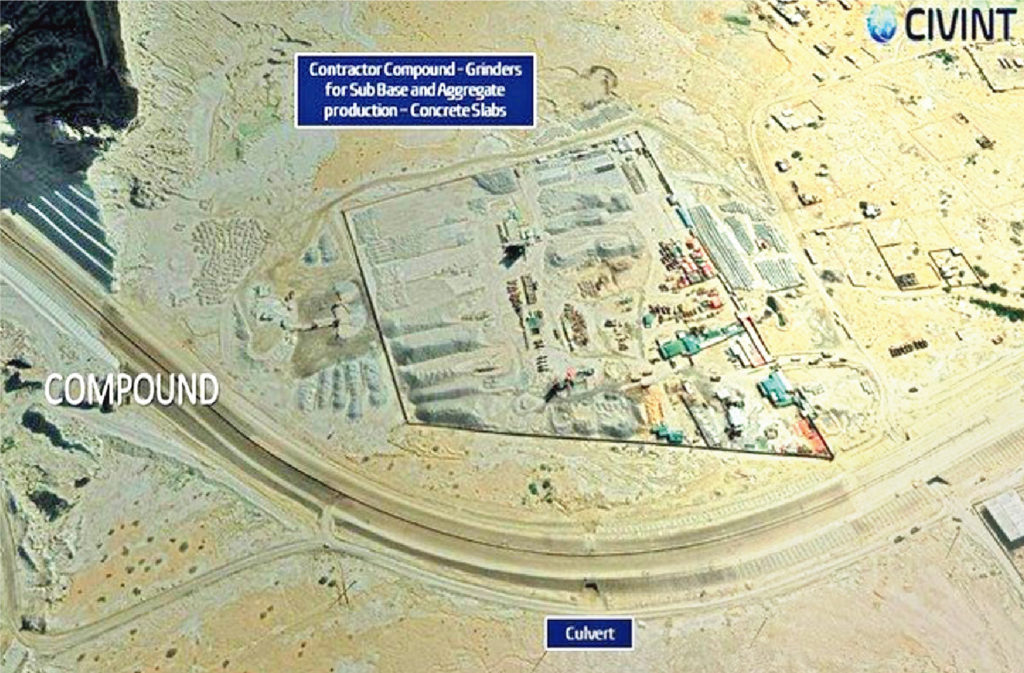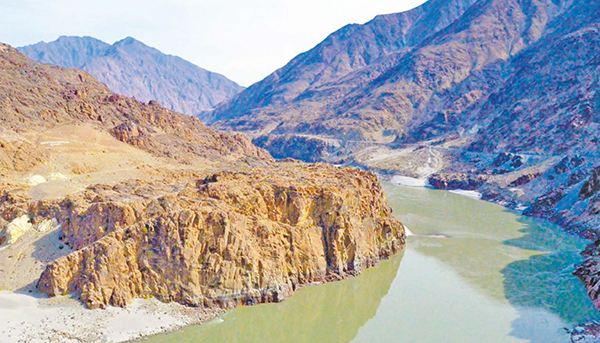On 20 May 2020, the Pakistan government signed a whopping Rs 442 billion ($5.8 billion) contract for a 70:30 joint venture between Chinese state-run firm China Power and Frontier Works Organisation (FWO), a commercial arm of the Armed Forces of Pakistan. The contract covers construction of a diversion system, main dam, access bridge and the 21MW Tangir hydropower project.
The dam will be constructed on the River Indus in Pakistan Occupied Kashmir (POK) region. When completed in 2028, the Diamer Bhasha dam, China’s first major civil engineering scheme in Kashmir, will have a 272-metre-high barrage, making it the tallest roller-compacted concrete dam in the world. The project will be part of the China-Pakistan Economic Corridor (CPEC), itself part of China’s Belt and Road Initiative.
It will have a generating capacity variously given as 4.8GW and 6GW, and will be situated in the region of Gilgit-Baltistan, about 320km from the Chinese border. As well as power, the dam will create a 200 sq km reservoir, greatly increasing Pakistan’s water security.
The first phase of the dam, worth $2.8bn, has been awarded to a team made up of China’s Power Construction Corporation and FWO, with 70% going to the Chinese company.
Pakistan’s Water and Power Development Authority (Wapda), announced the project on 20 May. Pakistan government will provide 30% funding and “the rest will be arranged by the Wapda” – understood to be a reference to loans from China. The total cost of the project is expected to be US$8.8bn, but earlier a figure of $14bn had been quoted.
In 2016, the project was named as one of the projects in the China-Pakistan Economic corridor. However, in 2017, Pakistan backed out when the Chinese demanded 100% ownership of the completed asset.
The eight million acre feet (MAF) reservoir with 272-metre height will be the tallest roller compact concrete (RCC) dam in the world. It will have a spillway, 14 gates and five outlets for flushing out silt. The diversion system involves two tunnels and a diversion canal — all three having one kilometre length each. The bridge — a box girder structure — under the contract will be constructed downstream of the dam structure while the 21MW power plant will be built to meet energy requirements of the project during construction.
India’s Objections
India has raised objections to the project, partly on political and partly on engineering grounds. The engineering objection is based on the safety of such a tall roller-compacted dam in an earthquake zone. The political protest is over India’s claim that the project legitimises Gilgit-Baltistan as part of Pakistan’s sovereign territory.
India said that undertaking such projects in territories under Pakistan’s illegal occupation was not proper. The Ministry of External Affairs said, “Our position is consistent and clear that entire territory of the Union Territories of Jammu and Kashmir and Ladakh have been, are and will continue to be integral and inalienable part of India.”
“We have consistently conveyed our protests and shared concerns with both Pakistan and China on all such projects in the Indian territories under Pakistan’s illegal occupation,” it said.
China defended the contract to build the Diamer-Bhasha dam in POK despite objection from India, saying that it was part of a “win-win” bilateral cooperation to promote the well being of the local population.
According to WAPDA, “In the event that the dam bursts at its proposed height of 272m during a routine seismic movement, 10 cubic kilometres of water, with the destructive power of a hydrogen bomb, will wipe out everything on the Indus all the way down to Sukkur.”
Roller-compacted dams use a blend of concrete in which fly ash is substituted for Portland cement, reducing the risk of thermal cracking during construction. The highest dam built so far using the method is the Gilgel Gibe III Dam in Ethiopia, at 250m.
Kohala Hydropower Project
China will also set up a 1,124-MW Kohala hydropower project in POK under the multi-billion-dollar CPEC despite India’s objection to it. The details of the project were presented in the 127th meeting of the Private Power and Infrastructure Board (PPIB) on 1 June.
A tripartite agreement has been finalised among China’s Three Gorges Corporation, the authorities in PoK and the PPIB to implement the project under the CPEC framework.
The project will be built on the Jhelum River and aims at annually providing more than five billion units of clean and low-cost electricity for consumers in Pakistan. The paper further reported that this marked one of the largest investments of $2.4 billion in an independent power producer (IPP) in the region.
The 3,000-km-long CEPC is aimed at connecting China and Pakistan with rail, road, pipelines and optical cable fiber networks. It connects China’s Xinjiang province with Pakistan Gwadar port, providing access to China to the Arabian Sea. The CPEC passes through PoK, over which India has conveyed its protests to China.
WAPDA has awarded a consultancy contract of the project to Diamer Basha Consultants Group (DBCG) worth 27.182 billion rupees ($168.8 million). DBCG joint venture comprises 12 top-ranked national and foreign consulting firms — Nespak (Pakistan), Associate Consulting Engineers (Pakistan), Mott MacDonald Pakistan, Poyry (Switzerland), Montgomery Watson and Harza (MWH) International-Stantec (USA), Dolsar Engineering (Turkey), Mott McDonald International (England), China Water Resources Beifang Investigation, Design and Research Company (China), Mirza Associates Engineering Services (Pakistan), Al-Kasib Group of Engineering Services (Pakistan), Development Management Consultant (Pakistan) and MWH Pakistan, with Nespak as the lead firm. These firms have a vast experience of providing consultancy services for mega water projects the world over.
The Council of Common Interests (CCI) had approved the project for construction in 2010, but it suffered delays because of international lending agencies which remained associated with the project but later backtracked because of opposition from India. The government has already spent about Rs170 bn on the project since then on land acquisition and other expenses. In view of the lenders’ resistance, it was decided about four years ago to divide the multi-purpose project into two major components — Rs650 bn worth of dam project to be constructed with the public sector funds and Rs750 bn worth of power project most probably to be developed in independent power producer (IPP) mode at a later stage.
====================
Satellites Detect Chinese Naval Base Plans at Gwadar
Recent satellite images shows that several new complexes have been built in the last few years in the Gwadar port complex. One of them, identified as being used by a Chinese company involved in port development, has unusually high security. These are considered the first signs of a long-expected Chinese naval base at Gwadar in Pakistan.


The high-security compound has been identified as being used by the China Communications Construction Company (CCCC Ltd). This is a majority state-owned company that is heavily involved in many Chinese civil engineering projects. While some degree of security is normal in the region, the level of security seen here is extensive.
It has anti-vehicle berms, security fences and a high wall. Sentry posts and elevated guard towers cover the perimeter between the fence and the inner wall. This suggests armed guards with rifles.
China has good reason to focus on security. The region, near the border with Iran and Afghanistan, is facing a long-standing insurgency. The Balochistan Liberation Army (BLA) seeks an independent state for the Baloch people. They carried out an attack on the Chinese Consulate in Karachi on November 23 2018, and on a hotel in Gwadar on May 11 2019. The latter attack targeted the Zaver Pearl-Continental 5-star Hotel, which is another centerpiece of Chinese investment in the town.
The high security compound is not alone. There are also two smaller sites built in the last year with rows of blue-roofed buildings. It has been suggested that these might be barracks for a Chinese Marine Corps garrison. China was reported to be deploying marines there back in March 2017. But the sites lack the level of security that would be expected. Whatever their exact purpose, their location and timing suggests that they are connected to the port expansion.
Located at the western end of Pakistan’s coast, Gwadar is expected to be a major port in China’s Belt and Road Initiative. This will allow Chinese goods to shortcut through Pakistan, instead of sailing all the way around South Asia. China was first reported to be planning a naval base there in January 2018. While the plan has never been confirmed officially, it would be a natural path.
The base, to complement an elaborate one in Djibouti, would strengthen China’s foothold in the Indian Ocean.
Whether the Chinese naval base materializes remains to be seen. But these new sites, including the heavily defended compound, may indicate that the next phase of port construction is imminent. And if the Chinese Navy does begin using the port it will strengthen their capabilities in the Indian Ocean.














[…] ALSO READ China to Construct Dam on Indus River in POK […]
[…] ALSO READ: INDIA-PAKISTAN: China to Construct Dam on Indus River in POK […]